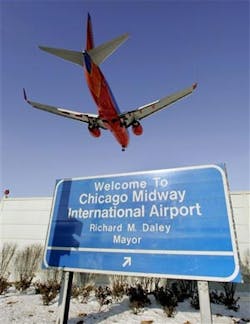Southwest Airlines officials say they're committed to expansion that could soon make Midway International Airport the carrier's busiest, plans unchanged by the airline's first fatal accident there earlier this month.
Two years of adding gates and flights already have made Midway the fastest-growing airport for Southwest, providing a strengthened base to compete with bigger rivals flying out of O'Hare International Airport across town.
Midway has surpassed Baltimore-Washington and tied Phoenix this year as Southwest's No. 2 airport with 196 daily departures. According to a recent Citigroup report, it is expected to overtake Las Vegas to become the Dallas-based carrier's largest airport by 2007.
Southwest spokeswoman Linda Rutherford said only that Midway "has the potential" to be its No. 1 airport by '07, declining to discuss specific plans for competitive reasons. But nearly two weeks after one of its jets skidded off a runway after landing in a snowstorm, killing a 6-year-old boy riding in a car, she said the airline remains unwavering in its commitment to Midway.
The Dec. 8 accident "does not change that Chicago Midway remains a focus city for us in terms of expansion opportunities and adding more flights," Rutherford said.
Southwest now controls 29 of the 43 gates at Midway, up from 19 a year ago as a result of deals made with ATA Holdings Corp., the bankrupt parent of fast-shrinking ATA Airlines.
Midway's shorter-than-average runways and lack of buffers at the ends of landing strips have been under scrutiny since the accident.
Rutherford, though, said the airline remains confident in the safety of its Midway operations.
"Southwest has been operating for 20 years at Midway and we have a daily dedication to safety for both customers and employees. We have a 34-year track record that proves that," she said.
The one-square-mile airport, located 8 miles southwest of downtown Chicago, was built in 1923 and is hemmed in by dense neighborhoods. It had gone since 1972 without a fatal accident.
Southwest's customers appear to have taken the rare accident in stride. The airline analyzed bookings following the accident and concluded there was no significant impact, Rutherford said.
Business-wise, Midway's location makes Southwest's continuing expansion a sound strategy.
"Midway is a gold mine for Southwest," said Jim Brown, an independent aviation consultant. "This is seen by a lot of frequent fliers and business travelers as a low-fare alternative to O'Hare."
O'Hare, located just 15 miles to the northwest, is the world's second-busiest airport behind Atlanta's Hartsfield-Jackson Atlanta International Airport in both total passengers and total flights, according to the Federal Aviation Administration. But it is twice the distance from downtown Chicago.
Numerous analysts and aviation experts said they would be surprised if the accident causes Southwest to slow its Midway expansion, barring an unexpected finding from the National Transportation Safety Board investigation.
"As unfortunate as the accident is, it doesn't materially change Southwest's operating plans," said Marisa Thompson of Morningstar Inc. "I don't think they would have expanded to Midway if they didn't think the runways were adequate."
Midway isn't technically a hub for Southwest, since the discount carrier flies point-to-point rather than operating a hub-and-spoke system like AMR Corp.'s American Airlines and UAL Corp.'s United Airlines, which use O'Hare and other big airports as bases for connecting flights. But the compact airport helps Southwest link flights to both coasts while also snagging more discount-minded travelers into and out of the third-largest U.S. city.
"Southwest has to expand aggressively over the next two to three years because they've got to spread out their costs in order to keep their fares down," said Denver-based airline consultant Michael Boyd. "They have high labor costs and in order to protect their costs they have to put out more product."
Southwest also faces a stiffer challenge from rival discounters such as fast-growing JetBlue and from bankruptcy-restructured carriers that offer not only competitive domestic fares but expanded international routes.
Midway offers more growth potential for Southwest than Las Vegas, Phoenix and other busy airports, according to William Warlick, airline industry analyst for Fitch Ratings.
"The Chicago market's a little more exciting right now in terms of opening up new destinations such as the West Coast - Oakland, Seattle, et cetera," he said.
Asked if Southwest might use its leverage with the city to effect runway improvements or other changes, Rutherford said that would be premature until all the facts surrounding the accident are known.
The city is reaping major benefits from Southwest's expansion, gaining both extra landing fees from the increased traffic and a $4.50 surcharge on each ticket sold. But New York-based airline consultant Robert Mann said all the growth brings additional issues to consider.
"Apart from the runway length, it's just a congested facility," he said. "Moving more gates to Southwest will mean more passengers and hence more congestion. It's great for the city ... but it exacts a toll on congestion and everything else."
News stories provided by third parties are not edited by "Site Publication" staff. For suggestions and comments, please click the Contact link at the bottom of this page.






